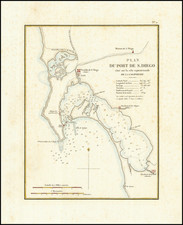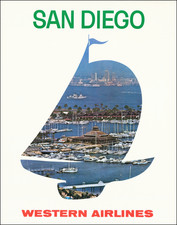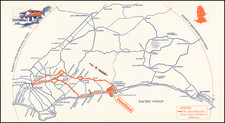Panoramic Photograph of Bertram Goodhue's San Diego Marine Corps Base
Handsome 1920s panoramic photograph with views of San Diego's iconic Marine Corps Recruiting Depot buildings. The top image is a bird's-eye view which shows the entire Marine Corps compound with a fine vista of San Diego Bay and Point Loma very clearly visible in the background. The lower image is a close-up view of the distinctive arched colonnade of the Spanish Colonial Revival buildings that comprise the MCRD. The latter view shows an airplane in midair, perhaps about to land on North Island. The photograph is captioned "U.S. Marine Barracks."
Bertram Goodhue and the Spanish Colonial Revival
The MCRD buildings were designed by noted architect Bertram Goodhue, who also designed most of the buildings of the Panama Pacific Exposition in San Diego's Balboa Park. Goodhue's largescale commissions in San Diego influenced local building styles and helped popularize the Spanish Colonial Revival. For the MCRD he used a somewhat stripped-down version of the Spanish style, with minimal decoration, incorporating the Mission-style arches more characteristic of his local architectural rival Irving Gill. Goodhue also designed buildings for the United States Military Academy in Westpoint, New York.
MCRD opened in 1921 as Marine Base San Diego and the present panoramic photograph was likely made soon after the opening, certainly in the first part of the 1920s.
O. A. Tunnell was active as a photographer in San Diego during the 1920s. He is noted for his panoramic views.
The Marines and San Diego
The story of MCRD San Diego began with Colonel Joseph Pendleton, who, after experiencing unsatisfactory conditions at Camp Howard on North Island, San Diego, advocated for a permanent Marine Corps base in the region. His speech on September 6, 1914, at the U.S. Grant Hotel in downtown San Diego, titled "San Diego, An Ideal Location for a Permanent Marine Corps Base," highlighted the need for better facilities for his men and staff. Around the same time, he wrote to the Commandant of the Marine Corps in Washington D.C., stressing the deplorable conditions at Camp Howard and proposing the idea of establishing a permanent base in San Diego.
The proposal gained traction, and the Navy General Board approved the establishment of a base on January 8, 1916. Subsequently, the Dutch Flats area was authorized for the Marine Corps base by a Naval appropriation bill on August 29, 1916, largely due to Congressman William Kettner's efforts. Groundbreaking on the 232-acre site occurred on March 2, 1919, with construction and occupation extending through 1926.
On December 1, 1921, Pendleton, now a General, officially commissioned the facility as the Marine Advanced Expeditionary Base, San Diego. In 1923, the Marine Recruit Depot for the west coast was relocated from the Mare Island Navy Shipyards in Vallejo, California, to the San Diego Marine Base. By March 1, 1924, the base was officially named Marine Corps Base, San Diego.
Rarity
This panorama is rare in the market. No examples recorded in OCLC, which only notes a handful of Tunnell's photographs, notably a 1919 panorama of President Woodrow Wilson greeting 50,000 people at Balboa Stadium in San Diego, held in the Library of Congress.
O.A. Tunnell was active as a photographer at San Diego, California, from 1918 to 1940.









![(California Photographs) [Group of 4 photographs of John H. Boden of Haywards, California, custom house broker in San Francisco]](https://storage.googleapis.com/raremaps/img/small/93197.jpg)
![(San Diego) [Manuscript letter by a young woman concerning Alonso Horton and Economic Conditions in San Diego, dated Dec. 4, 1877]](https://storage.googleapis.com/raremaps/img/small/97845.jpg)



![(19th-Century California Photograph) [Bird's-eye photograph view of Grass Valley, Cal. 1876]](https://storage.googleapis.com/raremaps/img/small/95393.jpg)